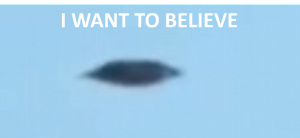Whether we believe in something or not depends on:
a) how believable it is
b) how believable the evidence is, and
c) how much we want to believe.
The first two points are the subject of ‘Sagan’s Razor’:
Extraordinary claims demand extraordinary evidence.
So, whereas the claim ‘Sorry I’m late, I slept in’ requires little proof, ‘Sorry I’m late, I was abducted by aliens’ would need:
Artifacts: Got any physical evidence we can test?
Recordings: Any recordings of image, sound or radiation that cannot be explained any other way?
or are we just dealing with
Testimonial: Did anyone else witness this? Do their stories match? How credible are these folks?

Consider alternate medicine. It claims undetectable cures (e.g. homeopathic solutions) can solve unverifiable problems (imbalances, subluxations etc.) by directing invisible energies (auras, prahna, chi) through undiscovered anatomical structures (chakras, meridians, nodes).
Extraordinary claims. So where’s the extraordinary proof? Physical artifacts? No. Recordings or measurements? Sorry. Results that can be repeated by people who aren’t already convinced? Nope.
Of course, there are plenty of testimonials from people completely sold on the healing powers of their magic bracelet, which brings us to the third factor:
c) how much we want to believe
…which really, is the big one.
If someone chooses to believe fantasy (or reject reality) it’s not because they’ve been convinced by the evidence. It’s because they really want (and very often need) to believe.
So hey, believe what you want. But don’t be surprised if the rest of us need proof… and the bigger the claim, the better it needs to be.
Steve Levakis
Interesting article that shows that our strongly held beleifs can compromise our thinking.
http://www.huffingtonpost.com/2013/10/10/politics-bad-math-study_n_4060350.html
dave isles
the cautionary note here is that just because we cant explain things in our personal frame of reference, doesnt make them ‘untrue’..
‘accept nothing that you have reason to doubt’… descartes, i think, but dont close your mind because it cant find a ‘conventional’ ‘provable’ explanation for real observations.
observations are the key, and experience is the teacher.. if it works for you, keep doing it.
the simplest explanation of the observations should always get the points.. yes, i did sleep in.. but keep an eye out for the ‘left field’ explanation… humans still have a lot learn!
Jason
I’ve always liked the old George Burns line ‘Keep your mind open, but don’t let your brains fall out’ – it’s been a healthy rule to live by. Carl Sagan said almost exactly the same thing (but his version was a lot longer and not as funny) – a working mind is always exploring new explanations and testing them for validity, but given that we might never know the truth for sure it’s good to have a handy rule of thumb like Sagan’s Razor. Consider ESP; exhaustively tested by leading researchers since the 1940’s (at a cost of many millions of dollars to governments around the world) and so far we’ve found exactly nothing. The scientific mind refuses to close the X-File, conceding that compelling results might be just around the corner, but a lesser intellect (like myself) might suspect ESP to be a mirage and want the resources spent on less mysterious, more productive endeavours like getting clean water to the entire world. If I were in charge of such things I think I’d risk closing my mind prematurely for the chance of pursuing a greater good. How about you?